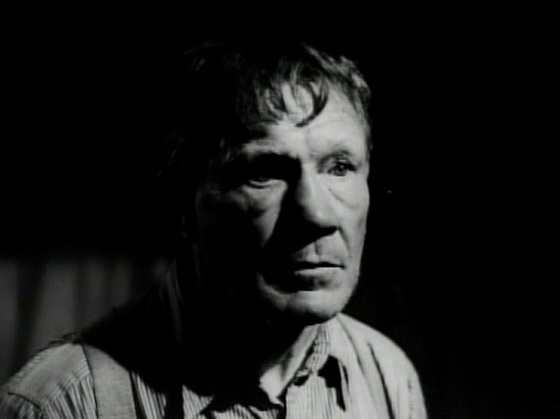Most people think of zombies as, depending on their age, either the slow moving walkers of George Romero’s movies or the athletic sprinters of films like 28 Days Later. The original cinematic zombies, however, were the voodoo zombies of films like White Zombie, Revolt of the Zombies, and I Walked with a Zombie, real people who were turned into the walking dead by witch doctors or Haitian priests. In 1942, a film that introduced traditional zombies into the murder mystery genre was made called The Living Ghost.

The Living Ghost stars James Dunn (who won an Oscar for A Tree Grows in Brooklyn) as Nick Trayne, a former private investigator who is asked to take on one more case; a wealthy banker named Walter Craig (The Mad Ghoul’s Gus Glassmire) has disappeared, and the millionaire’s best friend, Ed Moline (Shane’s Paul McVey), hires Nick to track him down. No sooner does Nick show up at the Craig house to interview Walter’s friends and family, than the banker returns home – but in a vegetative state. One of Walter’s friends, Dr. Bruhling (Lawrence Grant from Werewolf of London and Son of Frankenstein), diagnoses the man’s problem as a paralyzed cerebral cortex, and goes on to explain that his condition was brought on through the efforts of another person. With the help of Walter’s assistant, Billie Hilton (Joan Woodbury from King of the Zombies), Nick has to find out which of Walter’s acquaintances has put him into the zombie-like state before the culprit can do any more harm.

Towards the end of the Great Depression, Americans desperately needed their entertainment, so Hollywood found a way to make movies for as little money as possible. Produced by legendary Poverty Row studio Monogram Pictures, The Living Ghost is one of these cheap and quick flicks. The film was directed by the resourceful William Beaudine (The Face of Marble, The Ape Man), a filmmaker with a reputation for making movies on shoestring budgets in a matter of days. The screenplay, written by Joseph Hoffman (who would go on to write for television shows such as “Leave It to Beaver” and “My Three Sons”) and based on an original story by Howard Dimsdale (who also wrote for television, contributing to shows like “The Adventures of Robin Hood” and “Ben Casey”), is somewhat tame for the usually action-oriented Monogram, but Beaudine still manages to make The Living Ghost into an entertaining film.

The Living Ghost is a strange hybrid of a movie. Also known as A Walking Nightmare, it contains definite horror elements, but it is primarily a mystery, with Nick Trayne spending most of the movie trying to discover who put Walter Craig into his voodoo trance. The film is also very much a comedy, with Nick making wisecracks every chance he gets, and slapstick humor finding its way into the storyline at every turn. All in all, The Living Ghost was what people in the early forties wanted from their movies; it was entertaining, allowing audiences to escape from their everyday lives for a little over an hour.

As mentioned above, the zombies in The Living Ghost are not the typical horror movie zombies. There are only a couple of zombies in the film, and there is no brain eating or slow shuffling. The zombies do attack humans, but not in the bloodthirsty way that audience are used to; they are catatonic for most of the film, only moving when their master commands them to perform a task. They are much more traditional voodoo island zombies, living people who have been changed in order to do the bidding of the changer. In the decades to come, zombies would take on a completely different image, but the zombies in The Living Ghost were scary in their simplicity.

While making The Living Ghost, William Beaudine was forced to make the most of what he had. The film takes place in a mere handful of locations, with the bulk of it being shot in the same house. In addition to the simple sets, the actors are all dressed in normal, everyday clothes. There are no visual effects in the film, and the cinematography is very straightforward, almost as if the cast were performing a play for the camera. The lone exception to the simplistic camera work comes during a few scenes at an old shack on a dark and stormy night as Nick and Billie are investigating a lead; the lighting and shadows give the set a haunted look, resulting in the only truly frightening sequences in the film. Even those scenes are a lesson in restraint, proving that, in the hands of a filmmaker like William Beaudine, less is more. The Living Ghost is a textbook example of economical moviemaking.

One of the elements that makes The Living Ghost a unique horror movie is its snappy dialogue. The film is written very much like a murder mystery, so the language is somewhat “hard-boiled.” The rapid-fire conversation is full of wit, and it keeps the film entertaining, even during the lulls in the story. For example, at one point, when Nick is interviewing Walter’s family, one of them says of the situation that “it’s too monstrous to conceive,” to which Nick replies “I guess that’s why you thought of it.” In another exchange, this time with the family butler, Nick gets self-referential and says “why must there be a butler in every murder mystery?” James Dunn delivers the snarky discourse smoothly and effortlessly, making his character fun to watch, even when he’s just grilling the suspects. For a zombie movie, The Living Ghost has some very crafty dialogue.

Of course, Night of the Living Dead came along in the late sixties and transformed zombies into the brain-gobbling shuffle-walkers that are synonymous with the word today. But, until then, zombies were more supernatural than undead, and The Living Ghost is a fun example of what zombies once were.